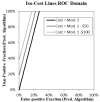A Utility/Cost Analysis of Breast Cancer Risk Prediction Algorithms
- PMID: 27335532
- PMCID: PMC4913185
- DOI: 10.1117/12.2217850
A Utility/Cost Analysis of Breast Cancer Risk Prediction Algorithms
Abstract
Breast cancer risk prediction algorithms are used to identify subpopulations that are at increased risk for developing breast cancer. They can be based on many different sources of data such as demographics, relatives with cancer, gene expression, and various phenotypic features such as breast density. Women who are identified as high risk may undergo a more extensive (and expensive) screening process that includes MRI or ultrasound imaging in addition to the standard full-field digital mammography (FFDM) exam. Given that there are many ways that risk prediction may be accomplished, it is of interest to evaluate them in terms of expected cost, which includes the costs of diagnostic outcomes. In this work we perform an expected-cost analysis of risk prediction algorithms that is based on a published model that includes the costs associated with diagnostic outcomes (true-positive, false-positive, etc.). We assume the existence of a standard screening method and an enhanced screening method with higher scan cost, higher sensitivity, and lower specificity. We then assess expected cost of using a risk prediction algorithm to determine who gets the enhanced screening method under the strong assumption that risk and diagnostic performance are independent. We find that if risk prediction leads to a high enough positive predictive value, it will be cost-effective regardless of the size of the subpopulation. Furthermore, in terms of the hit-rate and false-alarm rate of the of the risk-prediction algorithm, iso-cost contours are lines with slope determined by properties of the available diagnostic systems for screening.
Keywords: Risk prediction; breast cancer screening; diagnostic utility; expected cost.
Figures


References
-
- Lehman CD, Blume JD, Weatherall P, Thickman D, Hylton N, Warner E, Pisano E, Schnitt SJ, Gatsonis C, Schnall M. Screening women at high risk for breast cancer with mammography and magnetic resonance imaging. Cancer. 2005;103:1898–1905. - PubMed
-
- Saslow D, Boetes C, Burke W, Harms S, Leach MO, Lehman CD, Morris E, Pisano E, Schnall M, Sener S. American Cancer Society guidelines for breast screening with MRI as an adjunct to mammography. CA Cancer J Clin. 2007;57:75–89. - PubMed
Grants and funding
LinkOut - more resources
Full Text Sources
Other Literature Sources
